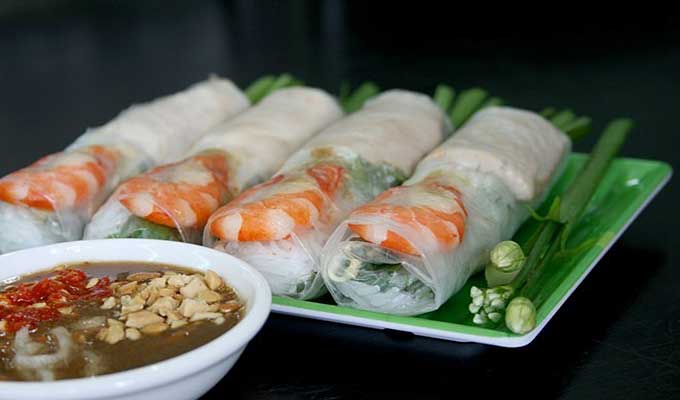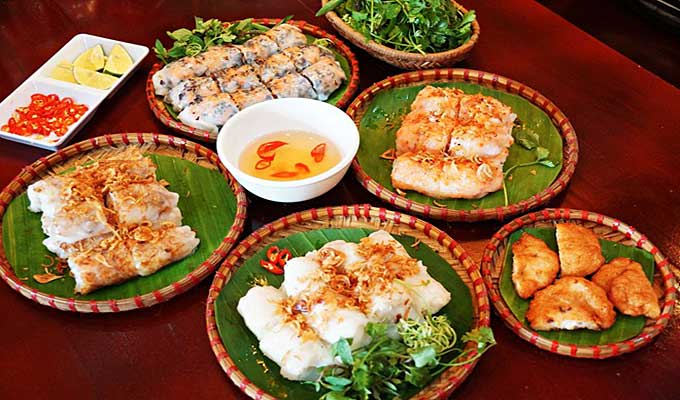Banh xeo (pancakes), nem nuong (baked rolls), banh cong (cong cakes)... are the roll cuisines that foreign tourists highly recommended to try in Viet Nam.
Bo bia (sausage spring rolls and peanut sauce): Bo Bia is a common street food in Viet Nam. It’s a refreshing crunchy rice paper rolls filled with jicama, eggs, chinese sausages, peanuts, herbs and lettuce, and served with hoisin, chili and peanut dipping sauce. Although the word “bo” means beef, there is no beef in this. The stuffing however can be diverse and include other items such as tofu, and bean sprouts.
Bo bia is very cheap. A roll is priced from VND2,000-VND5,000.
Goi cuon (Vietnamese pork and shrimp rolls with hoisin dipping sauce) is a Vietnamese dish traditionally consisting of pork, prawn, vegetables, rice vermicelli, and other ingredients wrapped in rice paper.

It is listed at number 30 on World's 50 most delicious foods complied by CNN Go in 2011.Fresh goi cuon have gained popularity among Vietnam’s neighboring countries and in the western hemisphere as well.
Goi cuon is a popular snack food in Vietnam and is usually ordered as an appetizer in Vietnamese restaurants stateside.
Banh cong (fried prawn cake) comes from the southern province of Soc Trang.
Coming to the Mekong Delta, after cruising along canals, shopping on the floating market and cycling around orchards, tourists should enjoy many rustic specialties, of which cong cake is suggested as a must-try dish.
Cong is made of rice planted in the delta. The rice flour after being stirred with warm water for around 20 minutes will be added to green beans, potatoes and pork together with spices and fried onion. Then you put shrimp in the mix with flour soaked in oil and fried until it turns golden brown.
The cake is especially tasty when fragrant and crispy. Diners will have a mouthwatering dish when the cake is served with brassica juncea together with many kinds of aromatic vegetables. Fish sauce mixed with sugar, chili, garlic and lemon will complete the delectability of the dish.
Crisp of flour, fragrance of rice and vegetables, light bitter of brassica juncea, sweetness of shrimp, fat of bean and moreish sauce will bring revelers a gastronomic experience and a half.
In Can Tho, tourists can find the dish along De Tham, Nguyen Trai or Ly Tu Trong streets.
Banh Khot (mounded rice cakes) is the specialty of the southern city of Vung Tau. It is a popular dish easily done and serving as breakfast.
The mounded rice cake is made of rice flour milled and seasoned with salt, sugar. Then coconut milk is added to make the mixture a bit greasy and saffron flour is also used for coloring. After being stuffed with ground shrimps, it was fried in the mould to have the small round shape. The dish is best served when it is still hot and eaten with raw vegetables, fresh chilies and shrimp paste.
The cake is the perfect combination of sweet, greasy and savory tastes that make it a great favorite for locals and tourists alike. Banh Khot can be found in food stalls scattered in some streets in Vung Tau city but the best place might be located on 14 Nguyen Truong To street. You can also taste banh khot in many restaurants in HCMC.
Banh xeo (Vietnamese pancake) is Vietnamese savory fried pancakes made of rice flour, water, and turmeric powder, stuffed with slivers of fatty pork, shrimp, diced green onion, and bean sprouts.
Ban xeo is served wrapped in mustard leaf, lettuce leaves or rice paper, and stuffed with mint leaves, basil, fish leaf and/or other herbs, and dipped in a sweet and sour diluted fish sauce.
In the Central region, the pancake is also dipped in a special sauce, which consists of fermented soybean and sticky rice sauce, ground pork liver, ground and toasted peanut and seasonings.
Banh cuon (Vietnamese rice noodle rolls) is a dish from Northern Viet Nam.

Banh cuon is made from a thin, wide sheet of steamed fermented rice batter filled with seasoned ground pork, minced wood ear mushroom, and minced shallots. Sides for this dish usually consist of cha lua (Vietnamese pork sausage), sliced cucumber, and bean sprouts, with the dipping sauce called nuoc cham. Sometimes, a drop of ca cuong, which is the essence of a giant water bug, Lethocerus indicus, is added to the sauce for extra flavor, although this ingredient is scarce and quite expensive.
The rice sheet in banh cuon is extremely thin and delicate. It is made by steaming a slightly fermented rice batter on a cloth which is stretched over a pot of boiling water. It is a light dish, and is generally eaten for breakfast everywhere in Vietnam.
Banh trang cuon thit heo is a popular cuisine in Vietnam, with various versions throughout the country. The major ingredients of this cuisine are rice paper, pork and fresh herbs.
Ca nuc hap cuon banh trang (steamed fish rice paper rolls) is another tasty roll cuisine, including steamed anchovy, fresh herbs rolled by rice paper.
Bo cuon la lot is beef wrapped in lot leaves which are typically grilled over a charcoal flame and is served as part of bo bay mon (seven courses of beef), with bun (vermicelli noodles), wrapped in lettuce rolls, wrapped in rice paper as a spring roll, or served on its own as appetizers. In raw form there is not much of a fragrance, but when grilled, the lot leaves impart a wonderful herbaceous and slightly peppery aroma to the beef. The aroma is truly unique and it also helps to seal in the beef’s moisture and juices.
Nem nuong (grilled sausage) is Vietnamese grilled pork sausage or grilled meatball, and a popular Vietnamese food item, sometimes served as an individual appetizer or snack, or served with rice noodles or rice as a main course.
Nem nuong is made of ground pork and some pork fat, thoroughly infused with chopped shallots, crushed garlic, fish sauce and some sugar, black pepper. After mixing all ingredients together, it's usually kept for half hour, or overnight, for marinating. The pork fat is meant to keep the nem nuong moist inside and slightly rich, as well giving a nice crisp browning on the exterior when grilled. Nem nuong are supposed to be savory and a little sweet to the taste.
Nem nuong can be eaten alone as an appetizer or snack, and dipped with sauce, referring to flavored fish sauce, or with a peanut dipping sauce.
Nem lui (grilled chopped meat) is pork mince, molded onto lemongrass skewers and grilled over charcoal.
The pork is wrapped in lettuce, and other greens including tart green starfruit and the herbs - sawtooth, perilla, spearmint amongst others associated with many Vietnamese dishes. The lemongrass is removed, then wrapped in rice paper and dipped into the nuoc leo (sauce), the name of the spicy peanut dip, enriched with pork liver.
Bo nhung dam (beef vinegar hotpot) is a popular and classic fondue dish because of the cozy way of eating and putting together your favorite mix of meat, vegetables and sauces. You can eat bo nhung dam in different ways. A fondue pan is placed in the middle of the dining table surrounded by bowls and plates of fresh vegetables, herbs, vermicelli and raw meat. A bowl of hot water is to soften the rice paper. Alternate with eating out of a bowl where you put some vermicelli, meat, vegetables, herbs and sauce. Everyone puts some meat in the fondue, and helps others, the elderly and children, to dish up and wrap salad rolls. Chopsticks are handy to use with fondues in order to get the meat from the pan, but fondue spoons and skimmers are also convenient.
The sauces used in Bo nhung dam are basic fish sauce Nuoc cham and anchovy dip Mam nem. The latter can be left out, which is really only for the connoisseur. If you haven’t learned to appreciate the smell of fish sauce, then Mam nem is certainly not an option for you.
The broth may be prepared in various ways. Vinegar with lemongrass is always the basic.